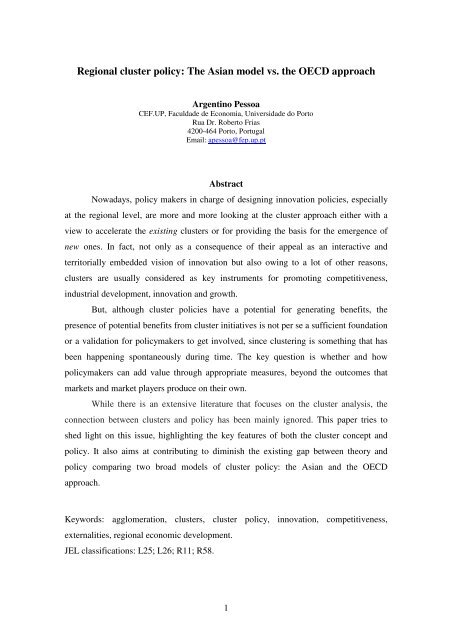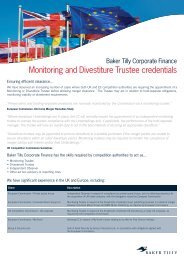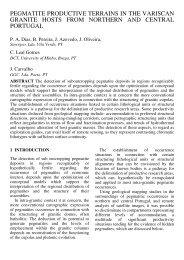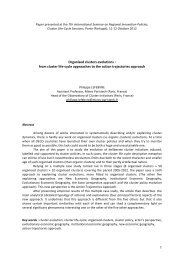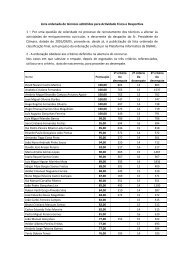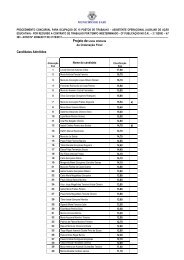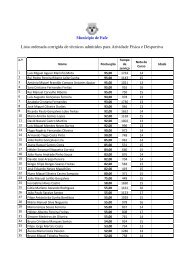Regional cluster policy: The Asian model vs. the ... - TextoVirtual.com
Regional cluster policy: The Asian model vs. the ... - TextoVirtual.com
Regional cluster policy: The Asian model vs. the ... - TextoVirtual.com
You also want an ePaper? Increase the reach of your titles
YUMPU automatically turns print PDFs into web optimized ePapers that Google loves.
<strong>Regional</strong> <strong>cluster</strong> <strong>policy</strong>: <strong>The</strong> <strong>Asian</strong> <strong>model</strong> <strong>vs</strong>. <strong>the</strong> OECD approach<br />
Argentino Pessoa<br />
CEF.UP, Faculdade de Economia, Universidade do Porto<br />
Rua Dr. Roberto Frias<br />
4200-464 Porto, Portugal<br />
Email: apessoa@fep.up.pt<br />
Abstract<br />
Nowadays, <strong>policy</strong> makers in charge of designing innovation policies, especially<br />
at <strong>the</strong> regional level, are more and more looking at <strong>the</strong> <strong>cluster</strong> approach ei<strong>the</strong>r with a<br />
view to accelerate <strong>the</strong> existing <strong>cluster</strong>s or for providing <strong>the</strong> basis for <strong>the</strong> emergence of<br />
new ones. In fact, not only as a consequence of <strong>the</strong>ir appeal as an interactive and<br />
territorially embedded vision of innovation but also owing to a lot of o<strong>the</strong>r reasons,<br />
<strong>cluster</strong>s are usually considered as key instruments for promoting <strong>com</strong>petitiveness,<br />
industrial development, innovation and growth.<br />
But, although <strong>cluster</strong> policies have a potential for generating benefits, <strong>the</strong><br />
presence of potential benefits from <strong>cluster</strong> initiatives is not per se a sufficient foundation<br />
or a validation for <strong>policy</strong>makers to get involved, since <strong>cluster</strong>ing is something that has<br />
been happening spontaneously during time. <strong>The</strong> key question is whe<strong>the</strong>r and how<br />
<strong>policy</strong>makers can add value through appropriate measures, beyond <strong>the</strong> out<strong>com</strong>es that<br />
markets and market players produce on <strong>the</strong>ir own.<br />
While <strong>the</strong>re is an extensive literature that focuses on <strong>the</strong> <strong>cluster</strong> analysis, <strong>the</strong><br />
connection between <strong>cluster</strong>s and <strong>policy</strong> has been mainly ignored. This paper tries to<br />
shed light on this issue, highlighting <strong>the</strong> key features of both <strong>the</strong> <strong>cluster</strong> concept and<br />
<strong>policy</strong>. It also aims at contributing to diminish <strong>the</strong> existing gap between <strong>the</strong>ory and<br />
<strong>policy</strong> <strong>com</strong>paring two broad <strong>model</strong>s of <strong>cluster</strong> <strong>policy</strong>: <strong>the</strong> <strong>Asian</strong> and <strong>the</strong> OECD<br />
approach.<br />
Keywords: agglomeration, <strong>cluster</strong>s, <strong>cluster</strong> <strong>policy</strong>, innovation, <strong>com</strong>petitiveness,<br />
externalities, regional economic development.<br />
JEL classifications: L25; L26; R11; R58.<br />
1
1. Introduction<br />
<strong>The</strong>re has been an increasing rhetoric about creating and supporting local industrial<br />
<strong>cluster</strong>s. <strong>The</strong> immediate reason is because political leaders and development agencies<br />
generally assume that industrial <strong>cluster</strong>s play a key role in regional development<br />
(Brachert et al, 2011), not only by boosting innovation (OECD, 1999) but also by acting<br />
as drivers of <strong>com</strong>petitiveness (Lagendijk, 1999, Morgan and Nauwelærs, 1999, Storper,<br />
1995) and usually empirical studies do not contradict <strong>the</strong>se <strong>the</strong>ses (Enright 1996;<br />
Isaksen 1997; Cooke 2001; Rosenthal and Strange, 2004; Spencer et al. 2009) 1 .<br />
Moreover, research in economic geography and regional science has empirically shown<br />
that agglomeration has been positively associated with productivity at <strong>the</strong> local level<br />
both in <strong>the</strong> US and in Europe (e.g., Ciccone and Hall, 1998; Ciccone, 2002). So, it is not<br />
surprising that building <strong>cluster</strong>s has quickly changed from a ‘fad’ to a ‘guiding principle’ of<br />
economic development <strong>policy</strong> (Raines, 2002).<br />
Although <strong>the</strong> study and discussion of industrial agglomeration has a long history in<br />
academic <strong>com</strong>munity discussions, it was <strong>the</strong> Porter’s <strong>com</strong>petitiveness concept that put it<br />
in <strong>the</strong> front page. In fact, it was only after Michael Porter (1990) has examined <strong>the</strong><br />
industrial agglomeration from <strong>the</strong> firm perspective that <strong>the</strong> <strong>the</strong>me surpassed <strong>the</strong><br />
restricted circles of economists and geographers. Porter’s consultant work, alone or in<br />
association with his Monitor Company, has contributed to <strong>the</strong> wide diffusion of <strong>cluster</strong><br />
strategies in many countries (Benneworth et al., 2003; Rosenfeld, 2005).<br />
But <strong>the</strong> Porter’s approach to industrial agglomerations helped not only to impose a<br />
concept and to justify <strong>cluster</strong>s as targets for public <strong>policy</strong>, but also it has created a<br />
global demand for consultants with policies to fit it, and this has had a cumulative effect<br />
on <strong>the</strong> popularity of <strong>cluster</strong>s. As Rosenfeld (2005: 4) has noted, this increasing demand<br />
of consultants can explain, almost partly, why industry <strong>cluster</strong>s have moved from a<br />
“relatively obscure idea situated on <strong>the</strong> periphery of economic development to a core<br />
practice”.<br />
Since <strong>the</strong> image of high productivity, prosperity, decentralization and<br />
entrepreneurship associated to <strong>the</strong> <strong>cluster</strong> brand has helped to promote <strong>the</strong> idea that a<br />
socially progressive local economy can be achieved by <strong>policy</strong> makers wherever regions<br />
1 Of course, <strong>the</strong>re are exceptions (e.g., Perry, 2010a).<br />
2
are located and whatever instruments are used, some authors consider <strong>cluster</strong> <strong>policy</strong><br />
popularity more as a result of <strong>the</strong> use of techniques of ‘brand management’ than as a<br />
genuine intellectual discourse (Martin and Sunley, 2003, Perry, 2010b).<br />
Some o<strong>the</strong>r criticisms are directed to both <strong>the</strong> Porter-inspired <strong>cluster</strong> developments<br />
that gave <strong>policy</strong> professionals a rationalization for local intervention and to <strong>the</strong><br />
proposed universal <strong>policy</strong> <strong>the</strong>rapy that assures sustained growth to any locality or region<br />
(Perry, 2010b). Policy makers in many countries and regions view <strong>the</strong>se developments<br />
as advice to <strong>com</strong>bine <strong>cluster</strong> support with any type of intervention, from simply<br />
recognizing <strong>the</strong> presence of a <strong>cluster</strong> to <strong>the</strong> <strong>com</strong>plete promotion of entirely new <strong>cluster</strong>s.<br />
But <strong>the</strong>re are many o<strong>the</strong>r criticisms: first, because in designing <strong>policy</strong> programmes,<br />
<strong>policy</strong>-makers often do not take into account some basic aspects of a <strong>cluster</strong> <strong>policy</strong>,<br />
applying <strong>the</strong> same measures to all supported local <strong>cluster</strong>s within a programme (Brenner<br />
and Schlump, 2011). Second, <strong>the</strong> scientific literature rarely provides re<strong>com</strong>mendations<br />
on how to select adequate <strong>policy</strong> measures in order to support <strong>cluster</strong>s. In fact, while<br />
<strong>the</strong>re does exist an extensive literature that deals with <strong>the</strong> <strong>cluster</strong> analysis, <strong>the</strong><br />
connection between this analysis and <strong>policy</strong> has been mainly ignored (Lorenzen, 2001).<br />
In face of <strong>the</strong> controversy about <strong>the</strong> <strong>cluster</strong> <strong>policy</strong> and from a regional <strong>policy</strong><br />
standpoint two questions are mandatory: first, can <strong>policy</strong> be effective in making appear<br />
new <strong>cluster</strong>s? Second, assuming its effectiveness, what is <strong>the</strong> appropriate <strong>policy</strong> for<br />
enforcing <strong>the</strong> <strong>cluster</strong>ing development and by that means promoting regional economic<br />
growth?<br />
<strong>The</strong> answer to <strong>the</strong> first question depends on <strong>the</strong> characteristics of <strong>cluster</strong>s and on<br />
<strong>the</strong> effectiveness of <strong>policy</strong> instruments to replicate such characteristics. Respecting to<br />
<strong>the</strong> second question, <strong>the</strong>re is not a consensual answer, as stated elsewhere (Pessoa,<br />
2011). <strong>The</strong> debate is polarized around two extreme positions: on <strong>the</strong> one hand, <strong>the</strong><br />
classical optimal-<strong>policy</strong> perspective (Rodríguez-Clare, 2007) and on <strong>the</strong> o<strong>the</strong>r <strong>the</strong><br />
Porter’s <strong>policy</strong> prescriptions 2 . <strong>The</strong>se extreme positions have a counterpart in two<br />
different regional patterns: <strong>the</strong> <strong>Asian</strong> <strong>model</strong> and <strong>the</strong> OECD <strong>model</strong>.<br />
2 <strong>The</strong>se prescriptions are syn<strong>the</strong>sized in Woodward and Guimaraes (2009): i) support <strong>the</strong> development of<br />
all <strong>cluster</strong>s, not choose among <strong>the</strong>m; ii) reinforce established and promising <strong>cluster</strong>s ra<strong>the</strong>r than attempt to<br />
create entirely new ones; iii) <strong>cluster</strong> initiatives are advanced by <strong>the</strong> private sector, with government as<br />
facilitator; iv) development should not be guided by top-down <strong>policy</strong> strategies.<br />
3
Accordingly, <strong>the</strong> remainder of this paper is organized as follows. After reflecting<br />
on <strong>the</strong> concept of <strong>cluster</strong> and on its key features in section 2, section 3 deals with <strong>the</strong><br />
difficulties in translating <strong>the</strong> key features highlighted by <strong>cluster</strong> analyses in <strong>policy</strong><br />
principles and instruments. Next, section 4 calls attention to <strong>the</strong> need of making <strong>cluster</strong><br />
<strong>policy</strong> suitable for <strong>the</strong> (actual or desirable) regional context. Section 5 presents two<br />
broad <strong>model</strong>s of <strong>cluster</strong> <strong>policy</strong>, contrasting <strong>the</strong> OECD approach with <strong>the</strong> <strong>Asian</strong> one.<br />
Finally, section 6 concludes.<br />
2. Clusters: key characteristics<br />
Since <strong>the</strong> 1990s, Michael Porter's work about ‘<strong>cluster</strong>s’ has increasingly established<br />
<strong>the</strong> standard in <strong>the</strong> field, and accordingly Porter's <strong>cluster</strong> <strong>model</strong> has been proposed in<br />
significant parts of <strong>the</strong> world as a tool for promoting national, regional, and local<br />
<strong>com</strong>petitiveness, innovation and growth. In fact, very quickly <strong>cluster</strong>s called <strong>the</strong><br />
attention of many leaders in many regions, and consequently <strong>the</strong> <strong>cluster</strong> related concepts<br />
were extended promptly to go with local circumstances and expectations. However, at<br />
least a large part of <strong>the</strong> popularity of <strong>cluster</strong>s lies in its vagueness and definitional<br />
elusiveness (Martin and Sunley, 2003) and it is likely that it would be this ambiguity<br />
that allows both to apply <strong>the</strong> <strong>cluster</strong> concept to different realities and to prevent an<br />
accurate <strong>policy</strong> evaluation. Fur<strong>the</strong>rmore <strong>the</strong> tendency to oversimplify, which is<br />
associated to <strong>the</strong> vulgarisation of <strong>the</strong> definition of “<strong>cluster</strong>”, permits to find <strong>cluster</strong>s<br />
everywhere. In effect, both individual researchers and development agencies have<br />
identified in recent years <strong>cluster</strong>s so diverse as ranging in size from two to thousands<br />
<strong>com</strong>panies, enveloping territories as small as a neighbourhood and as large as nations,<br />
and <strong>com</strong>prising highly specialized members as defined by a four digit industry code and<br />
as broadly defined as “high tech”. In today’s <strong>policy</strong> world, <strong>cluster</strong>s are acquiring “<strong>the</strong><br />
discreet charm of obscure objects of desire” as, citing Steiner (1998, p. 1), Martin and<br />
Sunley (2003) have reminded.<br />
So, <strong>the</strong>re is a lot of confusion around <strong>the</strong> <strong>cluster</strong> concept. A key characteristic of<br />
<strong>cluster</strong>s is <strong>the</strong> interdependence among firms. This interdependence gives <strong>cluster</strong>ed firms<br />
certain advantages over isolated firms. But is this interdependence a sufficient condition<br />
4
for classifying any association of firms (for instance, a network) as a <strong>cluster</strong>? In our<br />
view <strong>the</strong> answer is negative.<br />
In fact, <strong>the</strong>re are o<strong>the</strong>r groups of firms characterized by interdependence (i.e., firms<br />
are dependent on assets controlled by o<strong>the</strong>r partners). For instance, both <strong>cluster</strong>s and<br />
networks are characterised by independence and interdependence at <strong>the</strong> same time. But,<br />
<strong>the</strong>re are significant differences between <strong>cluster</strong>s and networks (Rosenfeld, 2005).<br />
According to Ceglie et al (1999: 270) “<strong>the</strong> term network refers to a group of firms that<br />
co-operate on a joint development project – <strong>com</strong>plementing each o<strong>the</strong>r and specialising<br />
in order to over<strong>com</strong>e <strong>com</strong>mon problems, achieve collective efficiency and conquer<br />
markets beyond <strong>the</strong>ir individual reach”. On <strong>the</strong> o<strong>the</strong>r hand <strong>the</strong> term <strong>cluster</strong> is used to<br />
indicate a “sectoral and geographical concentration of enterprises which, first, gives rise<br />
to external economies (such as <strong>the</strong> emergence of specialised suppliers of raw materials<br />
and <strong>com</strong>ponents or <strong>the</strong> growth of a pool of sector specific skills) and, second, favours<br />
<strong>the</strong> rise of specialised services in technical, administrative and financial matters. Such<br />
specialised services create an encouraging ground for <strong>the</strong> development of a network of<br />
public and private local institutions which support local economic development by<br />
promoting collective learning and innovation through implicit and explicit coordination”<br />
(Ceglie et al, 1999: 270).<br />
Table 1. Some differences between <strong>cluster</strong>s and networks<br />
Clusters<br />
Networks and firms’<br />
associations<br />
Free-riders Yes No<br />
Membership No Yes<br />
Formality Informal Formal<br />
Access Inclusive Exclusive<br />
Table 1 presents <strong>the</strong> most important differences between <strong>cluster</strong>s and o<strong>the</strong>r forms<br />
of firms’ associations. Both networks and <strong>cluster</strong>s are agglomerations of firms with<br />
certain <strong>com</strong>mon interests. According to Porter (1998, p. 78) “<strong>cluster</strong>s are geographic<br />
concentrations of interconnected <strong>com</strong>panies and institutions in a particular field”. But,<br />
contrasting with networks, nei<strong>the</strong>r “membership” in an organisation nor cooperation is<br />
required to be “in” a <strong>cluster</strong>. Free riders, just by virtue of location, are able to benefit<br />
from non-exclusive external economies that spill over people and organizations<br />
localized under <strong>the</strong> <strong>cluster</strong> influence. Clusters are informal and inclusive while networks<br />
5
are formal and exclusive, with members gaining advantages over non-members<br />
(Rosenfeld, 2005). In <strong>cluster</strong>s, free riders are not only unavoidable but also, and perhaps<br />
more importantly, contribute to make <strong>cluster</strong> more powerful.<br />
Ano<strong>the</strong>r recognized feature of <strong>the</strong> industry <strong>cluster</strong> concept is <strong>the</strong> proximity between<br />
businesses, which improves <strong>the</strong> exchange of knowledge and technologies. <strong>The</strong> benefits of<br />
proximity are well-known: Proximity makes greater access to tacit knowledge possible,<br />
opens opportunities for cooperation and collaboration and gives <strong>the</strong> <strong>cluster</strong>ed firms<br />
power to influence customers, markets, or policies. Proximity also gives higher access<br />
to experienced labour and allows firms to be more familiarized with <strong>com</strong>petitors’<br />
products and processes and to check own innovation and targets. In spite of <strong>the</strong><br />
influence of recent innovations, as Internet and overnight delivery, proximity go on<br />
being helpful for mapping <strong>the</strong> growth of territorial innovation systems (Morgan, 2004)<br />
and even crucial for some production inputs as key equipment and <strong>com</strong>ponents that are<br />
knowledge-intensive and/or result from interactive research and design (Rosenfeld,<br />
2005).<br />
But <strong>the</strong> importance of proximity in <strong>the</strong> transfer of tacit knowledge does not depend<br />
solely on geographical distance, as traditional explanations of <strong>the</strong> time and cost<br />
advantages of co-location tend to conclude (Gertler, 2003). Although geographic colocation<br />
increases <strong>the</strong> probability of interaction does occur, proximity has also a<br />
relational dimension (Boschma, 2005). This is important to keep in mind since <strong>the</strong><br />
exchange of strategically important information and knowledge requires mutual trust<br />
between <strong>the</strong> parties. In this sense, proximity is very related with <strong>the</strong> social capital<br />
concept highlighted by Putnam (1993) when he analyses <strong>the</strong> Italian economy.<br />
So, <strong>the</strong> proximity that is <strong>the</strong> key characteristic of a region possesses not only a<br />
spatial (geographical) dimension, but also a relational dimension. This involves aspects<br />
such as trust and understanding (Boschma, 2005). Although much of <strong>the</strong> literature<br />
agrees that spatial proximity often generates, or at least encourages, <strong>the</strong> emergence of<br />
relational proximity, this is nei<strong>the</strong>r an automatic nor an instantaneous result from<br />
geographic proximity, because trust between <strong>the</strong> actors is basically an effect of how<br />
long a particular relationship lasts, how frequent <strong>com</strong>munication between <strong>the</strong> actors is,<br />
and whe<strong>the</strong>r <strong>the</strong>y engage in repeated collaborations with <strong>the</strong> same actors (Nilsson,<br />
2008). So, despite how close two actors are in terms of geographical location, a lack of<br />
6
trust between <strong>the</strong>m can lead to <strong>the</strong> failure of wished interaction and knowledge<br />
exchange.<br />
In <strong>the</strong> case of <strong>the</strong> tacit dimension of knowledge, labour mobility between<br />
organisations is probably one of <strong>the</strong> most <strong>com</strong>mon channels for knowledge transfer<br />
between organisations in a region. Labour mobility also has a clear territorial dimension<br />
since <strong>the</strong> mobility of individuals between regions, and even more so between countries,<br />
is very limited. However, <strong>the</strong> experience of human resources has remained a primary<br />
reason of <strong>cluster</strong>ing (Krugman, 1991). Firms depend on a continuous flow of workers<br />
skilled with <strong>the</strong> necessary ability, and with <strong>the</strong> knowledge of <strong>the</strong> business, which are<br />
needed to both routine and unforeseen situations. In every <strong>cluster</strong> not only a sufficient<br />
provision of technicians, sales staff, network organization, but also a labour force<br />
experienced on <strong>the</strong> specific milieu in which <strong>the</strong> <strong>cluster</strong> functions are crucial. This is<br />
very hard to get when <strong>policy</strong> tries to create an entirely new <strong>cluster</strong>.<br />
On <strong>the</strong> o<strong>the</strong>r hand, <strong>the</strong> evidence suggests spontaneity in <strong>cluster</strong>s emergence. As<br />
shown by Rosenfeld (2005: 9), <strong>cluster</strong>s emerge out of a solid foundation that is ei<strong>the</strong>r<br />
embedded in existing <strong>com</strong>panies, local expertise, or some special resources. <strong>The</strong><br />
world’s best-known <strong>cluster</strong>s have a long history and were spontaneous until <strong>the</strong>y<br />
reached a sufficient level of activity. This suggests some sample bias in analyses of<br />
<strong>cluster</strong> benefits: usually, only <strong>the</strong> <strong>cluster</strong>s that call attention are studied and many<br />
potential <strong>cluster</strong>s disappear before <strong>the</strong>y constitute case studies. Perhaps this fact can<br />
explain some controversy about <strong>the</strong> positive effects of <strong>cluster</strong>s. In fact, if some<br />
researchers as Baptista and Swann (1998) conclude that innovation, entry and growth<br />
tend to be stronger in <strong>cluster</strong>s and that firms located in strong <strong>cluster</strong>s are more likely to<br />
innovate, o<strong>the</strong>rs (e.g., Perry, 2010a) state that, in practice, <strong>the</strong>re is no strong evidence<br />
that <strong>the</strong> businesses located in a <strong>cluster</strong> gain an advantage over those that do not.<br />
To sum up, economic history shows that <strong>the</strong> origins of <strong>cluster</strong>s are diverse and<br />
wide-ranging: we find <strong>cluster</strong>s that result from one or two successful <strong>com</strong>panies with<br />
employees with an entrepreneurial vision; or from <strong>the</strong> expansion of value added chains<br />
around very large firms; or even from efforts by laid off employees to use <strong>the</strong>ir<br />
<strong>com</strong>petencies in innovative ways. But, although <strong>the</strong>ir origin may be varied, spontaneity,<br />
relational dimension of proximity, tacit knowledge, interdependence and some<br />
informality are key characteristics of all of <strong>the</strong> best-known. All of <strong>the</strong>se characteristics<br />
7
are hardly created or manipulated by <strong>policy</strong>. So a <strong>policy</strong> that has as <strong>the</strong> main aim <strong>the</strong><br />
creation of <strong>cluster</strong>s is of difficult concretisation. However, difficulty doesn’t necessary<br />
means impossibility or ineffectiveness of that <strong>policy</strong>. It means <strong>the</strong> need of a conscious<br />
effort to study and over<strong>com</strong>e <strong>the</strong> arising problems.<br />
3. <strong>The</strong> difficult bridge: from <strong>the</strong>ory to <strong>policy</strong><br />
As noted in <strong>the</strong> Introduction, <strong>the</strong> idea of <strong>cluster</strong>s and <strong>cluster</strong> <strong>policy</strong> became popular in <strong>the</strong><br />
<strong>policy</strong> debate following <strong>the</strong> publication of Porter’s analyses about <strong>com</strong>petitiveness, at <strong>the</strong> dawn<br />
of <strong>the</strong> 1990s. But, contrasting with such popularity, <strong>the</strong> resulting <strong>policy</strong> inferences are much<br />
more controversial. Although Porter's definition of <strong>cluster</strong>s as “geographic concentrations of<br />
interconnected <strong>com</strong>panies, specialized suppliers, service providers, firms in related industries, and<br />
associated institutions (e.g. universities, standards agencies, trade associations) in a particular<br />
field that <strong>com</strong>pete but also cooperate” (Porter, 2000 p. 15) has be<strong>com</strong>e one of <strong>the</strong> most widely used<br />
in <strong>the</strong> <strong>cluster</strong> rhetoric, <strong>the</strong> consensus ends when <strong>policy</strong> needs an operative definition. Apart from <strong>the</strong><br />
idea that <strong>the</strong> presence of a <strong>cluster</strong> requires <strong>the</strong> analysis of <strong>the</strong> performance of a given industry to<br />
be made in close relation with <strong>the</strong> performance of related sectors and institutions, <strong>the</strong>re are<br />
many ambiguities surrounding <strong>the</strong> <strong>cluster</strong> concept, and its relationship with regional economic<br />
performance is poorly studied.<br />
Indeed, <strong>the</strong>re is no consensual definition of <strong>cluster</strong> from a <strong>policy</strong> point of view.<br />
Some consider “<strong>The</strong> <strong>cluster</strong> concept as, in fact, a specific type of a much larger family<br />
of “systems of innovation” approaches, or as reduced-scale national innovation systems<br />
(Roelandt and Hertog, 1999). <strong>The</strong> <strong>com</strong>mon starting-point of this perspective is “<strong>the</strong><br />
assumption that, in order to innovate successfully, firms need a network of suppliers,<br />
customers and knowledge-producing agents” (Roelandt and Hertog, 1999: 414). As<br />
results from an OECD book of Proceedings on Cluster <strong>policy</strong> (OECD, 1999), <strong>the</strong><br />
concept of <strong>cluster</strong> used in different countries is so diverse as ei<strong>the</strong>r Innovation systems<br />
(Canada, Mexico, Spain) or regional systems of innovation (UK), networks of<br />
production, networks of innovation etc. (Australia, Belgium, Switzerland); value chains<br />
and networks (USA), value chains and networks of production (Ne<strong>the</strong>rlands, Norway);<br />
industrial districts (Austria).<br />
Of course <strong>the</strong>re is a large literature about <strong>cluster</strong>s (Asheim and Isaksen, 1997; Feser,<br />
1998a, 1998b; Harrison, 1992; Heidenreich, 1996; Isaksen, 1997; Jacobs and de Man, 1996;<br />
8
Kaufman et al., 1994; Park and Markusen, 1995; Steiner, 1998), and from <strong>the</strong> work of <strong>the</strong>se,<br />
and many o<strong>the</strong>r authors, have resulted a refined analysis. However, many problems came across<br />
in translating <strong>the</strong> sophisticated and <strong>com</strong>monly understood analysis into effective <strong>policy</strong>.<br />
First, <strong>the</strong>re are some misunderstandings about how to consider <strong>cluster</strong> <strong>policy</strong>. While some<br />
<strong>policy</strong> makers consider <strong>cluster</strong> <strong>policy</strong> as a specific <strong>policy</strong> instrument, o<strong>the</strong>r analysts view<br />
<strong>cluster</strong>s as only an opportunity to apply a different guiding principle. In <strong>the</strong> latter interpretation<br />
<strong>the</strong> <strong>cluster</strong> <strong>policy</strong> consists of a better <strong>com</strong>prehension of <strong>the</strong> dynamic potential for growth of an<br />
industrial agglomeration. It means taking a closer look at <strong>com</strong>plementarities within given or<br />
potential economic structures, helping to define priorities in regional development programmes<br />
and to fine-tune <strong>the</strong> supply of public research and educational institutions (Peneder, 1999: 354).<br />
Second, while <strong>the</strong> studies on <strong>cluster</strong>s state that <strong>the</strong>y may generate knowledge<br />
spillovers and enhanced innovation (Camagni, 1991; Cooke, 2002; Maskell and<br />
Malmberg, 1999; Porter, 1998), <strong>the</strong> channels of knowledge transmission ei<strong>the</strong>r remain<br />
unclear (Tödtling et al., 2009) or are described as multiple and varied. In <strong>the</strong> letter case,<br />
<strong>the</strong> channels may be, for instance, patents or scientific articles (Jaffe et al., 1993),<br />
observation and imitation of <strong>com</strong>petitors (Malmberg and Maskell, 2002), and<br />
development of spin-offs or <strong>the</strong> relocating of qualified labour (Keeble and Wilkinson,<br />
2000).<br />
Also o<strong>the</strong>r analyses emphasize o<strong>the</strong>r perspectives on <strong>the</strong> sources of knowledge<br />
spillovers. For instance, in studying <strong>the</strong> US semiconductor industry, Ketelhöhn (2006)<br />
classified <strong>the</strong> sources of spillovers in four main categories: buyers (Morris, 1990;<br />
Smith, 2000; Leslie, 2000), suppliers and related industries (Morris, 1990, Macher et<br />
al., 1998), <strong>com</strong>petitors (Braun and McDonald, 1978), and academic institutions (Braun<br />
and McDonald, 1978; Morris, 1990; Saxenian, 1994).<br />
O<strong>the</strong>r authors explain dynamic externalities as resulting from processes of localised<br />
learning (Maskell et al., 1998; Maskell and Malmberg, 1999; Malmberg and Maskell,<br />
2006). This means that learning appears as <strong>the</strong> key way of transmitting knowledge in<br />
territorially industrial agglomerations and, consequently, to know how and under what<br />
principles knowledge can be transmitted is decisive for designing and implementing an<br />
effective regional <strong>policy</strong>.<br />
<strong>The</strong> localized learning can occur between many entities and through multiple<br />
processes, such as learning by doing, learning by using, learning by interacting. It<br />
involves three facets: horizontal, vertical and multi-level learning. <strong>The</strong> horizontal<br />
9
learning is performed between firms mostly belonging to <strong>the</strong> same industry and<br />
providing similar goods and services. At this level, <strong>the</strong> relationship between firms is a<br />
<strong>com</strong>posite of <strong>com</strong>petition and cooperation, for short, coopetition 3 . As <strong>the</strong> similar<br />
producing conditions and <strong>the</strong> existence of a “<strong>com</strong>mon language” benefit <strong>the</strong><br />
<strong>com</strong>munication and knowledge transfer, <strong>the</strong> learning process consists of <strong>com</strong>paring,<br />
observing and imitating each o<strong>the</strong>r. Proximity offers <strong>the</strong> firms <strong>the</strong> possibility of<br />
conveniently and freely observing and evaluating <strong>the</strong> innovation activities of o<strong>the</strong>rs,<br />
which reduce <strong>the</strong> cognitive distance and enhance <strong>the</strong> absorptive capability of <strong>cluster</strong>ing<br />
firms.<br />
Vertical learning refers to forward and backward interactions of firms located in<br />
different points of <strong>the</strong> value chain, i.e., <strong>the</strong> learning between providers and consumers<br />
and <strong>the</strong> learning between producers and suppliers. By keeping a close contact with<br />
users, <strong>cluster</strong>ing firms can acquire timely market information (Malmberg and Power<br />
2005). Especially, <strong>the</strong> sophisticated buyers usually ask for <strong>the</strong> superior quality and high<br />
reliable production, which contribute to design and upgrade production. On <strong>the</strong> o<strong>the</strong>r<br />
hand, <strong>the</strong> backward learning helps firms to acquire <strong>com</strong>plementary technology to<br />
upgrade <strong>the</strong>ir design and to profit from <strong>the</strong> effects of <strong>the</strong>ir provider’s R&D. In <strong>cluster</strong>s,<br />
owing to long-term cooperation and high trust, <strong>the</strong> clients and <strong>the</strong> suppliers are able to<br />
<strong>com</strong>municate each o<strong>the</strong>r widely and freely, which facilitates <strong>the</strong> exchange of open<br />
information and helps to solve <strong>com</strong>mon problems.<br />
Multi-level learning refers to <strong>the</strong> interactive learning between firms and o<strong>the</strong>r<br />
local actors, such as <strong>the</strong> local governments, universities, public research institutes and<br />
o<strong>the</strong>r organizations. <strong>The</strong>se organizations provide local firms with all kind of services<br />
and infrastructure, which promote knowledge-sharing and cooperation. Especially as for<br />
<strong>the</strong> knowledge and technology infrastructure, university and public research institutes<br />
not only perform a role in education, training and technology transfer but also create<br />
new ideas, knowledge and technology.<br />
In sum, although <strong>the</strong> <strong>cluster</strong> analysis can present a huge amount of mechanisms<br />
that explain how <strong>cluster</strong>s are associated to <strong>com</strong>petitiveness and innovation, <strong>the</strong>se<br />
features have been more fully exploited in economic analyses than in <strong>the</strong> design of<br />
3 While <strong>the</strong> <strong>com</strong>petition can focus on <strong>the</strong> <strong>com</strong>mon raw material, labour force and goods market, <strong>the</strong><br />
cooperation is more likely on <strong>the</strong> creation of a <strong>com</strong>mon market, <strong>the</strong> establishment and maintenance of a<br />
<strong>com</strong>mon brand and so on.<br />
10
policies (Bergman and Feser, 1999). Given <strong>the</strong> large quantity of channels and <strong>the</strong><br />
diversity of sources of positive externalities, it is understandable <strong>the</strong> non-existence of a<br />
single, predefined path to be followed in <strong>the</strong> implementation of <strong>cluster</strong> promotion<br />
initiatives (Ceglie et al., 1999: 286). In fact, we face a new difficulty, which now results<br />
from <strong>the</strong> distinct processes of <strong>the</strong>ory and <strong>policy</strong>, but once more this doesn’t mean <strong>the</strong><br />
impossibility of <strong>cluster</strong> <strong>policy</strong>, this only means <strong>the</strong> need to bridge <strong>the</strong> sophisticated<br />
<strong>cluster</strong> analysis with <strong>the</strong> more practical in nature <strong>cluster</strong> <strong>policy</strong>. Anyway, if <strong>the</strong> sources<br />
of positive externalities are so evident and abundant as <strong>the</strong> <strong>cluster</strong> analysis highlights,<br />
market fails in providing efficient allocation of resources and, consequently, <strong>policy</strong> has<br />
a role to play in efficiency and growth grounds.<br />
4. Cluster <strong>policy</strong> and regional context<br />
An important characteristic highlighted in recent literature about Innovation is<br />
<strong>the</strong> mutual embeddedness between institutions and organizations i.e., firms and o<strong>the</strong>r<br />
organizations are strongly influenced and shaped by institutions. Organizations can be<br />
said to be ‘embedded’ in an institutional environment or set of rules, which include <strong>the</strong><br />
legal system, norms, standards, etc. But institutions are also ‘embedded’ in<br />
organizations. Hence, <strong>the</strong>re is a <strong>com</strong>plex two-way relationship of mutual embeddedness<br />
between institutions and organizations, and this relationship influences innovation<br />
processes and <strong>the</strong>reby also both <strong>the</strong> performance and change of systems of innovation.<br />
(Edquist and Johnson, 1997). <strong>The</strong> institutions shape (and are shaped by) <strong>the</strong> actions of<br />
<strong>the</strong> organizations, and so <strong>cluster</strong> support initiatives need to be flexible and in tune with <strong>the</strong><br />
characteristics of <strong>the</strong> environment where firms operate.<br />
But, on <strong>the</strong> o<strong>the</strong>r hand, <strong>cluster</strong>s should be thought of embedded in <strong>the</strong> territory and so it<br />
is necessary to know <strong>the</strong> regional context where <strong>cluster</strong>s exist or should be inserted. So, <strong>the</strong><br />
design of a regional <strong>cluster</strong> <strong>policy</strong> forces <strong>the</strong> answer to ano<strong>the</strong>r fundamental question: Is <strong>the</strong><br />
<strong>cluster</strong> <strong>policy</strong> aimed at improving <strong>the</strong> current characteristics of <strong>the</strong> region or, on <strong>the</strong> contrary, at<br />
transforming regional characteristics as, for instance, specialization, openness to foreign trade or<br />
public-private relationships. Anyway, <strong>the</strong> answer needs a previous analysis of <strong>the</strong> regional<br />
context, which can be made using two strands of <strong>the</strong> literature: ei<strong>the</strong>r <strong>the</strong> industrial districts<br />
perspective or <strong>the</strong> regional innovation systems approach.<br />
11
a) Industrial districts<br />
Markusen (1996) identified four distinct types of industrial agglomerations that<br />
differ by industry dynamic, corporate priorities, government involvement, financing,<br />
and employment structure: a) Marshallian-Italianate industrial district; b) Hub-andspoke<br />
district; c) satellite platform district and d) State-anchored industrial district.<br />
According to Markusen (1996) a skilled and flexible labor force that is <strong>com</strong>mitted to<br />
<strong>the</strong> region and deep networks defines Marshallian-Italianate districts. <strong>The</strong>se characteristics<br />
allow Marshallian-Italianate regions to identify and support emerging industries, and to<br />
respond quickly to economic and technology shifts. <strong>The</strong>se environments tend to develop in<br />
regions without a history of economic dominance from one or several leading corporations<br />
because <strong>the</strong>y require effective labour division, to which established <strong>com</strong>panies might<br />
oppose. For instance <strong>the</strong> Marshallian-Italianate features apparent in <strong>the</strong> Shanghai region<br />
help to explain <strong>the</strong> emergence of high-tech <strong>cluster</strong>s in proxy Chinese cities in sou<strong>the</strong>rn<br />
Jiangsu and nor<strong>the</strong>rn Zhejiang provinces (Walenza-Slabe, 2012).<br />
In Hub-and-Spoke districts, i.e., in regions where one or a few large <strong>com</strong>panies<br />
dominate <strong>the</strong> regional economy, suppliers accumulate to meet demand from <strong>the</strong> leading<br />
<strong>com</strong>panies, and over time <strong>the</strong> economic activity may attract new, unrelated industries.<br />
<strong>The</strong>se environments tend to be <strong>com</strong>pany-centric, with employees devoted to <strong>com</strong>panies<br />
ra<strong>the</strong>r than <strong>the</strong> region as a whole. Companies tend to be highly self-sufficient and are thus<br />
generally disinterested in cooperation with o<strong>the</strong>r regional <strong>com</strong>panies, who may be<br />
<strong>com</strong>petitors. <strong>The</strong>y are more likely to seek strategic partnerships with outside <strong>com</strong>panies.<br />
Due to <strong>the</strong> prevalence of large vertical <strong>com</strong>panies and mass markets, Walenza-Slabe<br />
(2012) sees in Beijing and Shanghai regions illustrative examples of Hub-and-Spoke<br />
regions’ features.<br />
Satellite Industrial districts are often promoted by central governments as a means<br />
of developing target regions. Local industry tends to be dominated by <strong>the</strong> subsidiaries or<br />
suppliers of outside <strong>com</strong>panies, who may be domestic or foreign. Inter-<strong>com</strong>pany<br />
cooperation is generally weak due to <strong>the</strong> lack of effective networks. However, <strong>com</strong>pany<br />
engagement in <strong>the</strong> region tends to be stable and may eventually lead <strong>the</strong> region towards a<br />
Hub-and-Spoke environment as <strong>the</strong> region gains in importance. Satellite regions face<br />
unique growth disputed due to <strong>the</strong>ir reliance on external financing, strategic direction and<br />
technical expertise. This type of industrial district is more likely to be associated to a <strong>policy</strong><br />
targeted to create new <strong>cluster</strong>s than to a <strong>policy</strong> for <strong>cluster</strong> development. For instance, <strong>the</strong><br />
12
Chengdu region illustrates a Satellite environment due to its role as a regional hub in <strong>the</strong><br />
government’s <strong>policy</strong> of industrializing western China (Walenza-Slabe, 2012).<br />
<strong>The</strong> business environments of State-Anchored districts are deeply influenced by<br />
government institutions and revenue and so regional economic growth is driven by <strong>the</strong><br />
government policies that allocate funding. Although <strong>the</strong> State-Anchored districts tend to be<br />
structurally similar to Hub-and-Spoke regions <strong>the</strong>re is a fundamental difference: <strong>the</strong> local<br />
economy is dominated by government spending ra<strong>the</strong>r than by large corporations.<br />
Consequently a top-down <strong>cluster</strong> <strong>policy</strong> has more chances of being succeeded in State-<br />
Anchored districts than in o<strong>the</strong>r types of industrial districts. <strong>The</strong> capital city regions are<br />
frequent examples of State-Anchored economies, since <strong>the</strong> majority of large corporations<br />
locate <strong>the</strong>ir headquarters in <strong>the</strong> capital city by many reasons and among <strong>the</strong>m with <strong>the</strong><br />
intention of improving access to government bureaucracies (Walenza-Slabe, 2012).<br />
b) <strong>Regional</strong> Innovation Systems<br />
Also <strong>the</strong> type of RIS (<strong>Regional</strong> Innovation System) must be taken in account in <strong>the</strong><br />
implementation of a <strong>cluster</strong> <strong>policy</strong>. Let’s illustrate with <strong>the</strong> Asheim and Gertler’s (2005)<br />
taxonomy of RIS. According to this classification <strong>the</strong>re are three types of RIS:<br />
territorially embedded regional innovation system, also recognized as “grassroots RIS”;<br />
regionally networked innovation system, also called “network RIS”; and regionalized<br />
national innovation system, also known as “dirigiste RIS”.<br />
<strong>The</strong> territorially embedded regional innovation system corresponds to a system<br />
where firms (mainly those employing syn<strong>the</strong>tic knowledge) base <strong>the</strong>ir innovation<br />
activity on localized learning processes stimulated by proximity without much direct<br />
interaction with knowledge organizations. This is <strong>the</strong> case of many South European<br />
Industrial Districts, as for instance <strong>the</strong> Italian ones. In “grassroots RIS” as in Marshallian-<br />
Italianate regions (Markusen, 1996) <strong>the</strong> flexible labour force <strong>com</strong>mitted to <strong>the</strong> region and <strong>the</strong><br />
deep networks allow to identify and support emerging industries, and to respond quickly to<br />
economic and technology shifts.<br />
On <strong>the</strong> o<strong>the</strong>r hand, a regionally networked innovation system is a regional<br />
agglomeration of firms surrounded by a regional supporting institutional infrastructure.<br />
It is usually <strong>the</strong> result of <strong>policy</strong> intervention to increase innovation capacity and<br />
13
collaboration in cooperation with local universities and R&D institutes. <strong>The</strong> basic idea<br />
is that technology transfer agencies and service centers supplement firms’ <strong>com</strong>petence.<br />
In this type of RIS <strong>the</strong> <strong>policy</strong> intervention is used not only to increase collective<br />
innovation capacity but it may also be useful in counteracting technological “lock-in”<br />
within regional <strong>cluster</strong>s of firms. <strong>The</strong> “network RIS” is most typical of Germany,<br />
Austria, and <strong>the</strong> Nordic countries.<br />
Finally, <strong>the</strong> regionalized national innovation system is <strong>the</strong> result of a process of<br />
<strong>cluster</strong>ing R&D laboratories of large firms and governmental research institutes in<br />
planned “science parks”. It is a <strong>model</strong> where exogenous actors and relationships play a<br />
larger role. That is, innovation activity takes place primarily with actors outside <strong>the</strong><br />
region (lack of local and regional embeddeness) and significant parts of <strong>the</strong> industry are<br />
more integrated into national or international innovation systems. <strong>The</strong> most notorious<br />
examples are <strong>the</strong> technopoles of France or <strong>the</strong> science parks in Japan and Taiwan. In <strong>the</strong><br />
“dirigiste RIS” as in State-Anchored regions (Markusen, 1996), a top-down <strong>cluster</strong><br />
<strong>policy</strong> is more likely to be succeeded than in territorially embedded regional innovation<br />
system.<br />
5. Two <strong>model</strong>s of <strong>cluster</strong> <strong>policy</strong><br />
But, if <strong>the</strong>re are several types of industrial agglomerations and <strong>policy</strong> should be<br />
designed in tune with targeted industrial districts or <strong>Regional</strong> Innovation Systems, it is likely a<br />
diversity of <strong>cluster</strong> policies. Also if <strong>the</strong>re is no consensual definition of <strong>cluster</strong> it is<br />
expected that in practice, countries’ <strong>cluster</strong> <strong>policy</strong> approaches differ. However, in spite<br />
of some differences in underling concepts <strong>the</strong>re is a notable consensus in OECD<br />
countries: <strong>the</strong> preference for a bottom-up approach. This focuses on fostering dynamic<br />
market functioning and removing market imperfections; <strong>the</strong> foundation lies in marketinduced<br />
initiatives, with <strong>the</strong> government acting as a catalyst and mediator but with no<br />
setting of national priorities (<strong>the</strong> Ne<strong>the</strong>rlands, <strong>the</strong> United States). When <strong>the</strong> top-down<br />
approach, is used (for instance, in some Nordic countries) it has an exceptional<br />
character. In this case, government (in consultation with industry and research agencies)<br />
sets some national priorities, formulates a challenging vision for <strong>the</strong> future and decides<br />
on <strong>the</strong> actors to be involved in <strong>the</strong> conversation. But, after national priorities have been<br />
14
set and <strong>the</strong> dialogue groups implemented, <strong>the</strong> <strong>cluster</strong>ing process be<strong>com</strong>es a market-led<br />
process, with little government intervention (Roelandt and Hertog, 1999).<br />
In our view this preference for bottom-up approach is more ideological than<br />
based in sound economic principles, reflecting <strong>the</strong> far<strong>the</strong>st position of a pendulum<br />
movement. Development <strong>policy</strong> has always been subject to fashions <strong>com</strong>manded by<br />
ideology. During <strong>the</strong> 1950s and 1960s, industrial <strong>policy</strong>, import-substitution and <strong>the</strong><br />
“big push”, were <strong>the</strong> straight cries of <strong>policy</strong> makers both in developed and developing<br />
nations. In <strong>the</strong> 1970s <strong>the</strong>se ideas were replaced with more market-friend and outwardorientation<br />
approaches. By <strong>the</strong> late 1980s, a set of <strong>policy</strong> principles usually known as<br />
“<strong>the</strong> Washington Consensus” (Williamson, 1990) obtained a remarkable convergence of<br />
views among international institutions in charge of dealing with aid and finance<br />
problems of developing countries. In spite of many criticisms (Pessoa, 2004; Rodrik,<br />
2003) <strong>the</strong>se principles, initially designed for <strong>the</strong> developing world and put in place in<br />
some Latin America countries, spread to <strong>the</strong> high-in<strong>com</strong>e economies and remain at <strong>the</strong><br />
core of today’s conventional understanding of a desirable <strong>policy</strong> framework for<br />
economic growth in <strong>the</strong> Occidental World.<br />
So additionally to some developing countries, also in developed world <strong>the</strong><br />
principles of <strong>the</strong> Washington Consensus, and particularly <strong>the</strong> principles of privatisation<br />
and deregulation, paved <strong>the</strong> way of a change in development <strong>policy</strong> and consequently<br />
<strong>the</strong> 1990s have seen a shift away from “picking winners” towards “letting <strong>the</strong> market<br />
pick winners”. This change affected <strong>the</strong> design of development policies and <strong>the</strong> <strong>cluster</strong><br />
<strong>policy</strong> is not an exception. In fact, such principles are underling <strong>the</strong> way as <strong>cluster</strong><br />
<strong>policy</strong> is seen in <strong>the</strong> OECD countries. Accordingly, <strong>the</strong> OECD <strong>model</strong> of <strong>cluster</strong>-based<br />
industrial <strong>policy</strong>-making is based on <strong>the</strong> following prescriptions (Roelandt and Hertog,<br />
1999: 420-421):<br />
1. <strong>The</strong> creation of <strong>cluster</strong>s should not be government-driven but ra<strong>the</strong>r should result<br />
from market-induced and market-led initiatives.<br />
2. Government <strong>policy</strong> should not be strongly oriented to directly subsidising<br />
industries and firms or to limiting rivalry in <strong>the</strong> marketplace.<br />
3. Government <strong>policy</strong> should shift away from direct intervention towards indirect<br />
inducement. Public interference in <strong>the</strong> marketplace only can be justified in <strong>the</strong><br />
presence of a clear market or systemic failure. Even if clear market and systemic<br />
15
imperfections exist, it cannot necessarily be concluded that government<br />
intervention will improve <strong>the</strong> situation.<br />
4. Government should not try to take <strong>the</strong> direct lead or ownership in <strong>cluster</strong><br />
initiatives, but should work as a catalyst and broker, bringing actors toge<strong>the</strong>r and<br />
supplying support structures and incentives to facilitate <strong>the</strong> <strong>cluster</strong>ing and<br />
innovation process.<br />
5. Cluster <strong>policy</strong> should not ignore small and emerging <strong>cluster</strong>s; nor should it focus<br />
only on “classic”, existing <strong>cluster</strong>s.<br />
6. Clusters should not be created from “scratch”.<br />
<strong>The</strong>se prescriptions are all negative. <strong>The</strong>y show what government should not to do.<br />
But <strong>the</strong> question is: if government is dealing with creating and supporting local<br />
industrial <strong>cluster</strong>s, what is <strong>the</strong> role that government must play? According to <strong>the</strong> OECD<br />
principles above, <strong>policy</strong> should consist of creating favourable framework conditions for<br />
an efficient and dynamic functioning of markets only. But, given <strong>the</strong> extensive amount<br />
of positive externalities highlighted by many authors, <strong>cluster</strong> <strong>policy</strong> is just motivated by<br />
<strong>the</strong> market failures. And when market fails, <strong>policy</strong> must play <strong>the</strong> role that market fails to<br />
play. In fact, <strong>cluster</strong> and networks can be seen, to some extent, as public goods reducing<br />
transaction costs by internalising transactions involving external economies and so <strong>policy</strong><br />
measures should correct market failures implied by <strong>the</strong> existence of <strong>the</strong>se positive externalities.<br />
Economic <strong>the</strong>ory teaches that <strong>the</strong>y call for, and justify, active public policies.<br />
In our view <strong>the</strong> <strong>Asian</strong> <strong>model</strong> is more effective in creating and supporting <strong>cluster</strong>s and<br />
consequently in fostering economic growth. In <strong>the</strong> <strong>Asian</strong> <strong>model</strong> <strong>policy</strong> is based on a<br />
sequence of actions described by Akifumi Kuchiki (2005, p. 1) as <strong>the</strong> “flowchart<br />
approach”. This approach to industrial <strong>cluster</strong> <strong>policy</strong> “emphasizes <strong>the</strong> importance of <strong>the</strong><br />
ordering of <strong>policy</strong> measures. <strong>The</strong> flow of <strong>policy</strong> implementation is to establish an<br />
industrial zone, to invite an anchor <strong>com</strong>pany, and to promote its related <strong>com</strong>panies to<br />
invest in <strong>the</strong> industrial zone” (Kuchiki, 2005, p. 1). This approach is usually<br />
ac<strong>com</strong>panied by a precise formalization of incentives and procedures intended to aid<br />
foreign business and attract FDI. <strong>The</strong> example of Shanghai is elucidative. Through <strong>the</strong><br />
Shanghai Foreign Investment Development Board (2011), <strong>the</strong> Shanghai municipality<br />
has formalized incentives, policies and procedures intended to aid foreign business and<br />
16
attract FDI. First, some Municipal administrative agencies were created and <strong>the</strong><br />
assistance available to foreign investors was clearly defined (see table 2).<br />
Table 2. Functions of Shanghai Municipal administrative agencies<br />
Shanghai Municipal administrative<br />
agencies:<br />
Foreign Investment Commission<br />
Development and Reform Commission<br />
Economic Commission<br />
Commission of Science and Technology<br />
Source: SFIDB (2011), article 4.<br />
Function:<br />
Financial oversight<br />
Project approval<br />
Aligning FDI with local development goals<br />
Technology partnerships and “technology<br />
for market access” deals<br />
Also precise conditions for investment and incentives are typified in Shanghai<br />
Foreign Investment Development Board (SFIDB, 2011), for instance: a) incentives are<br />
only available for investments of more than $2 million in foreign capital and if 80% of<br />
enterprise staff is full-time professional research and development personnel (Article 5);<br />
b) exemptions from customs duties and value added taxes on imports for approved<br />
<strong>com</strong>panies (Article 6); c) up to 50% deduction of taxable in<strong>com</strong>e for approved<br />
<strong>com</strong>panies (Article 7); d) land grants and subsidized rent for approved R&D facilities<br />
(Article 8). By clarifying <strong>the</strong> incentives available to foreign investors and <strong>the</strong> constraints<br />
under which <strong>the</strong>y must operate, Shanghai and o<strong>the</strong>r large cities have been succeeded in<br />
attracting capital and new business by reducing <strong>the</strong> uncertainty of operating in a foreign<br />
country so singular as China.<br />
But <strong>the</strong> sequence of actions is ac<strong>com</strong>panied by <strong>the</strong> creation of “sufficient<br />
conditions” for <strong>the</strong> success of <strong>the</strong> <strong>cluster</strong> <strong>model</strong>. First, both organizations in <strong>the</strong> local<br />
public sector and firms in <strong>the</strong> private sector provide for capacity to industrial zones<br />
respecting to physical infrastructure, institutions, and human resources. Second,<br />
industrial <strong>cluster</strong> <strong>policy</strong> to provide industrial zones and capacity as semi-public goods<br />
can enhance regional economic growth in cases where an anchor firm operates under<br />
increasing returns to scale 4 . Third, <strong>the</strong> minimum optimal size of production is defined<br />
4 Of course, this approach is facilitated by <strong>the</strong> fact that markets for sales in China are at an early stage of<br />
development and large enough for anchor <strong>com</strong>panies to attain increasing returns to scale. However,<br />
increasing returns can be attained in many o<strong>the</strong>r countries and regions.<br />
17
according to <strong>the</strong> economies of scale and depending on <strong>the</strong> size of fixed capital of <strong>the</strong><br />
related <strong>com</strong>panies of anchor <strong>com</strong>panies.<br />
Bottom-up is <strong>the</strong> rule<br />
Table 3. Contrasting <strong>the</strong> OECD with <strong>the</strong> <strong>Asian</strong> <strong>model</strong><br />
OECD <strong>model</strong><br />
Top-down is exceptional<br />
Government acts only as a catalyst and<br />
mediator<br />
Clusters should not be created from<br />
“scratch”.<br />
<strong>Asian</strong> (except Japan) <strong>model</strong><br />
In <strong>the</strong> origin, is always a top-down<br />
approach<br />
Combines well <strong>the</strong> top-down approach<br />
with <strong>the</strong> bottom-up approach.<br />
Government also sets national priorities<br />
Government builds industrial zones and for<br />
each one invites an anchor <strong>com</strong>pany<br />
Creating entirely new <strong>cluster</strong>s<br />
Table 3 shows <strong>the</strong> most important differences between <strong>the</strong> two approaches. <strong>The</strong><br />
<strong>Asian</strong> <strong>model</strong> <strong>com</strong>bines well <strong>the</strong> top-down approach with <strong>the</strong> bottom-up approach. In <strong>the</strong><br />
origin is always a top-down approach: <strong>the</strong> government acts not only as a catalyst and<br />
mediator but also setting national priorities and devising a challenging vision for <strong>the</strong><br />
future. <strong>The</strong> flow of <strong>policy</strong> implementation is to establish an industrial zone, to invite an<br />
anchor <strong>com</strong>pany, and to promote its related <strong>com</strong>panies to invest in <strong>the</strong> industrial zone.<br />
Next, <strong>the</strong> recipient country’s government reduces its role in order to promote<br />
<strong>com</strong>petition. It <strong>the</strong>reby transfers greater authority to local governments and makes more<br />
use of <strong>the</strong> public corporations and state enterprises at <strong>the</strong> same time as it gradually gives<br />
an increasing role to <strong>the</strong> market. <strong>The</strong> progress and spreading out of <strong>cluster</strong>s and network<br />
creation in Asia by both national (and local) public enterprises and multinational<br />
corporations are considered fundamentals to <strong>the</strong> upgrading of Asia’s industrial<br />
structures.<br />
On <strong>the</strong> o<strong>the</strong>r hand, in OECD countries a hands-off approach is preferred. With a<br />
significant distrust in industrial <strong>policy</strong>, <strong>the</strong>se countries take a passive attitude waiting for<br />
projects presented by private initiatives. <strong>The</strong>y maintain significant bureaucratic<br />
organizations, with roles of writing regulations, classify projects and attributing money<br />
to <strong>the</strong> approved projects. <strong>The</strong> capacity of originating <strong>cluster</strong>s is only a criterion among<br />
many o<strong>the</strong>rs. But if externalities are not accounted in <strong>the</strong> profitability of firms, why <strong>the</strong><br />
projects presented by private agents must include <strong>cluster</strong>s as a decisive factor?<br />
18
As previously noted <strong>the</strong> importance of <strong>cluster</strong> <strong>policy</strong> results from positive<br />
externalities associated to <strong>the</strong> <strong>cluster</strong>ing mode of production (Pessoa, 2011), which<br />
make increasing returns likely. If private initiative is not aware of <strong>the</strong> external effects of<br />
its action it doesn’t orient projects according to <strong>the</strong> capacity <strong>the</strong>y have for generating<br />
<strong>cluster</strong>s. In <strong>the</strong> OECD <strong>model</strong> government waits for <strong>the</strong> action of private initiative while<br />
this waits for government. <strong>The</strong> result is a low level equilibrium, where <strong>cluster</strong>s only<br />
appear by fortuity.<br />
6. Conclusion<br />
<strong>The</strong> <strong>cluster</strong> <strong>policy</strong> approach gives <strong>policy</strong> makers better chances for getting <strong>the</strong>ir<br />
priorities right. However, our literature review shows that both <strong>the</strong> <strong>cluster</strong> concept is<br />
usually poorly defined and very often some <strong>cluster</strong> characteristics, which are difficult to<br />
be manipulated by <strong>policy</strong> (spontaneity, informality, tacit knowledge, etc.), are<br />
overlooked. Additionally, <strong>the</strong> vagueness in <strong>the</strong> definition of <strong>cluster</strong> concept makes<br />
difficult <strong>the</strong> <strong>policy</strong> evaluation at <strong>the</strong> same time as <strong>the</strong> appealing of <strong>the</strong> “<strong>cluster</strong> brand”<br />
drives to an exaggerated optimism in <strong>the</strong> expected effects of <strong>cluster</strong> <strong>policy</strong>.<br />
But this paper revolved around ano<strong>the</strong>r paradox: why so many <strong>policy</strong> makers in<br />
<strong>the</strong> OECD countries use <strong>the</strong> <strong>cluster</strong>s rhetoric inspired in <strong>the</strong> <strong>com</strong>petitive advantages of<br />
Porter but, in practice, don’t use <strong>the</strong> <strong>policy</strong> instruments needed to propagate <strong>cluster</strong>s?<br />
<strong>The</strong> answer to this question is closely associated to <strong>the</strong> <strong>policy</strong> makers’ faith on <strong>the</strong><br />
superiority of market over <strong>the</strong> government <strong>policy</strong>. However, this faith is more motivated<br />
by ideological convictions than by scientific principles. <strong>The</strong> <strong>cluster</strong> <strong>policy</strong> is not an<br />
exception to this hands-off approach that is spreading in <strong>the</strong> OECD countries giving<br />
<strong>policy</strong> a shift away from “picking winners” towards “letting <strong>the</strong> market pick winners”. But if<br />
this is <strong>the</strong> case why <strong>policy</strong> is needed? This paper provides arguments that show this is not<br />
<strong>the</strong> most appropriate strategy to boost economic development, as <strong>the</strong> contrast between<br />
OECD regions and <strong>the</strong> ones localized in <strong>the</strong> “<strong>Asian</strong> triangle of growth” demonstrate.<br />
19
References<br />
Arrow KJ (1962) <strong>The</strong> economic implications of learning by doing. Review of Economic<br />
Studies 29: 155–173.<br />
Asheim, B.T. and A. Isaksen (1997), “Location, Agglomeration, and Innovation: Towards<br />
<strong>Regional</strong> Innovation Systems in Norway?”, European Planning Studies, Vol. 5, No. 3,<br />
pp. 299-330.<br />
Baptista, Rui and Peter Swann (1998). Do firms in <strong>cluster</strong>s innovate more?, Research<br />
Policy 27, pp. 525–540.<br />
Beaudry C, Schiffauerova A (2009) Who’s right, Marshall or Jacobs? <strong>The</strong> localization<br />
versus urbanization debate. Research Policy 38: 318–337.<br />
Benneworth, P., Danson, M., Raines, P. and Whittam, G. (2003) Confusing <strong>cluster</strong>s:<br />
making sense of <strong>the</strong> <strong>cluster</strong> approach in <strong>the</strong>ory and practice, European Planning<br />
Studies, 11(5), pp. 511–520.<br />
Bergman, E.M. and E.J. Feser (1999), “Industry <strong>cluster</strong>s: a methodology and framework for<br />
regional development <strong>policy</strong> in <strong>the</strong> United States”, chapter 11 in OECD (1999) Boosting<br />
Innovation: <strong>The</strong> Cluster Approach OECD Publications Service, Paris, France.<br />
Boekholt, Patries and Ben Thuriaux (1999), “Public Policies To Facilitate Clusters:<br />
Background, Rationale and Policy Practices in International Perspective”, chapter 16 in<br />
OECD (1999) Boosting Innovation: <strong>The</strong> Cluster Approach OECD Publications<br />
Service, Paris, France.<br />
Boschma, R. (2005). “Proximity and Innovation: A Critical Assessment”, <strong>Regional</strong><br />
Studies 39(1) pp. 61-74.<br />
Brachert, Matthias, Mirko Titze and Alexander Kubis (2011), Identifying industrial<br />
<strong>cluster</strong>s from a multidimensional perspective: Methodical aspects with an<br />
application to Germany, Papers in <strong>Regional</strong> Science, Volume 90 Number 2, pp.<br />
419-40.<br />
Braun, E., MacDonald, S. (1978) Revolution in Miniature: <strong>The</strong> history and impact of<br />
semiconductor electronics. Cambridge: Cambridge University Press.<br />
Brenner Thomas and Charlotte Schlump (2011): Policy Measures and <strong>the</strong>ir Effects in <strong>the</strong><br />
Different Phases of <strong>the</strong> Cluster Life Cycle, <strong>Regional</strong> Studies, 45:10, 1363-1386<br />
Buerger, Matthias and Uwe Cantner (2011). <strong>The</strong> regional dimension of sectoral<br />
innovativeness: An empirical investigation of two specialized suppliers and two<br />
science-based industries, Papers in <strong>Regional</strong> Science, Volume 90 Number 2 June<br />
2011, pp. 373-394.<br />
Ceglie, Giovanna, Michele Clara and Marco Dini (1999), “Cluster and network<br />
development projects in developing countries: lessons learned through <strong>the</strong><br />
20
UNIDO experience” chapter 11 in OECD (1999) Boosting Innovation: <strong>The</strong> Cluster<br />
Approach OECD Publications Service, Paris, France.<br />
Coe, David, and Elhanan Helpman (1995), "International R&D Spillovers." European<br />
Economic Review, Vol. 39(5), pp. 859-87.<br />
Coe, David, Elhanan Helpman and Alexander Hoffmaister (1997), "North-South R&D<br />
Spillovers", Economic Journal, Vol. 107, pp. 134-49.<br />
Ciccone, A. and R. E. Hall, 1996. Productivity and <strong>the</strong> Density of Economic Activity.<br />
American Economic Review, 86 (1): 54-70.<br />
Ciccone, A. 2002. Agglomeration Effects in Europe, European Economic Review, 46:<br />
213-227.<br />
Cooke P (2001) Clusters as key determinants of economic growth: <strong>The</strong> example of<br />
biotechnology. In: Mariussen A (ed) Cluster policies – <strong>cluster</strong> development?<br />
Nordregio Report 2001/2, Stockholm.<br />
DAVID, P. A. and J. L. ROSENBLOOM (1990), Marshallian factor market<br />
externalities and <strong>the</strong> dynamics of industrial location. Journal of Urban Economics<br />
28, pp. 349–370.<br />
de Groot, H. L. F., Poot, J. & Smit, M. J. (2008). Agglomeration externalities,<br />
innovation and regional growth: <strong>The</strong>oretical perspectives and meta-analysis.<br />
(Department of Economics Working Paper Series, Number 1/08). Hamilton, New<br />
Zealand: University of Waikato.<br />
Duranton, Gilles and Diego Puga, 2001. "Nursery Cities: Urban Diversity, Process<br />
Innovation, and <strong>the</strong> Life Cycle of Products," American Economic Review, vol.<br />
91(5), pages 1454-1477.<br />
Edquist, C. and B. Johnson (1997). ‘Institutions and organisations in systems of<br />
innovation’, in C. Edquist (ed.) Systems of Innovation: Technologies, Institutions<br />
and Organizations. London and Washington: Pinter/Cassell Academic.<br />
Enright M (1996) <strong>Regional</strong> <strong>cluster</strong>s and economic development: A research agenda. In:<br />
Staber U, Schaefer N V, Sharma B (eds) Business networks: Prospects for<br />
regional development. De Gruyter, New York.<br />
Feldman, M. (2000) Location and Innovation: <strong>the</strong> new economic Geography of<br />
innovation, spillovers, and agglomeration. In GL Clark, M. Feldman, and M.<br />
Gertler (eds.). Oxford Handbook of Economic Geography. Oxford: Oxford<br />
University Press, pp. 373-394.<br />
Feldman, M, and Audretsch DB. 1999. Innovation in cities: science-based diversity,<br />
specialization and localized <strong>com</strong>petition. European Economic Review 43(2): 409–<br />
429.<br />
21
Florida, R. (2002) Bohemia and Economic Geography, Journal of Economic Geography<br />
2: 55-71.<br />
Frenken, K., FG Van Oort, and T. Verburg (2007). Related variety, unrelated variety<br />
and regional economic growth, <strong>Regional</strong> Studies 41(5): 685-697.<br />
Gertler M (2003) Tacit knowledge and <strong>the</strong> economic geography of context, or <strong>the</strong><br />
undefinable tacitness of being (<strong>the</strong>re). Journal of economic geography 3(1): 75-<br />
99.<br />
Glaeser, E. L. and J. D. Gottlieb, 2009. <strong>The</strong> Wealth of Cities: Agglomeration<br />
Economies and Spatial Equilibrium in <strong>the</strong> United States. Journal of Economic<br />
Literature, 47: 983-1028.<br />
Glaeser Edward L, and David Maré. 2001. Cities and Skills. Journal of Labor<br />
Economics. April;Vol. 19(No 2):316–342.<br />
Glaeser, Edward L., Hedi D. Kallal, Jose A. Scheinkman and Andrei Shleifer, 1992.<br />
"Growth in Cities," Journal of Political Economy, vol. 100(6), pages 1126-52<br />
Grabher, G. (1993) <strong>The</strong> weakness of strong ties: <strong>the</strong> ‘lock-in’ of regional development<br />
in <strong>the</strong> Ruhr area. In G. Grabher (ed.) <strong>The</strong> Embedded Firm: On <strong>the</strong> Socioeconomics<br />
of Industrial Networks, pp. 255–277. London: Routledge.<br />
Henning, M., J. Moodysson & M. Nilsson. 2010. Innovation and regional<br />
transformation: from <strong>cluster</strong>s to new <strong>com</strong>binations. Malmö: Region Skåne.<br />
Huang, Z., X. Zhang, and Y. Zhu. 2008. <strong>The</strong> role of <strong>cluster</strong>ing in rural industrialization:<br />
A case study of Wenzhou’s footwear industry. China Economic Review 19: 409–<br />
420.<br />
Isaksen A (1997) <strong>Regional</strong> <strong>cluster</strong>s and <strong>com</strong>petitiveness: <strong>The</strong> Norwegian case.<br />
European Planning Studies 5: 65–76.<br />
Jaffe, A., Trajtenberg, M., Henderson, R., 1993. Geographic localization of knowledge<br />
spillovers as evidenced by patent citations. Quarterly Journal of Economics 108<br />
(3), 577–598.<br />
Jacobs, J., 1969. <strong>The</strong> Economy of Cities, Penguin, London.<br />
Jacobs, J., 1984. Cities and <strong>the</strong> Wealth of Nations: Principles of Economic Life,<br />
Vintage, New York.<br />
Keeble, D., Wilkinson, F. (Eds.), 2000. High-Technology Clusters, Networking and<br />
Collective Learning in Europe. Ashgate, Aldershot.<br />
Ketelhöhn, Niels W. (2006) <strong>The</strong> role of <strong>cluster</strong>s as sources of dynamic externalities in<br />
<strong>the</strong> US semiconductor industry, Journal of Economic Geography, 6 (5): 679-699.<br />
Krugman, P. 1991. Geography and trade. Cambridge, MA: MIT Press.<br />
22
Leslie, S. W. (2000) <strong>The</strong> biggest “Angel” of <strong>the</strong>m all: <strong>the</strong> military and <strong>the</strong> making of<br />
Silicon Valley. In M. Kenney (ed.) Understanding Silicon Valley: <strong>The</strong> Anatomy of<br />
an Entrepreneurial Region. Stanford, CA: Stanford University Press, 48–67.<br />
Lorenzen, Mark (2001): Localized Learning and Policy: Academic Advice on Enhancing<br />
<strong>Regional</strong> Competitiveness through Learning, European Planning Studies, 9(2): 163-185<br />
Macher, J. T., Mowery, D. C., Hodges, D. A. (1998) Reversal of fortune? <strong>The</strong> recovery<br />
of <strong>the</strong> US semiconductor industry. California Management Review, 41: 107–136.<br />
Malmberg, A., Maskell, P., 2002. <strong>The</strong> elusive concept of localization economies:<br />
towards a knowledge-based <strong>the</strong>ory of spatial <strong>cluster</strong>ing. Environment and<br />
Planning A 34 (3), 429–449.<br />
Malmberg, Anders and Maskell, Peter, 2006, “Localized Learning Revisited.” Growth<br />
and Change 37(1): 1-18.<br />
Markusen, Ann (1996), “Sticky Places in Sloppery Space: A Typology of Industrial<br />
Districts”, Economic Geography, vol. 72(3), 293-313.<br />
Maskell P. and A Malmberg (1999) Localised learning and industrial <strong>com</strong>petitiveness,<br />
Cambridge Journal of Economics, 23 (2), 167-185.<br />
Maskell, P., Eskelinen, H., Hannibalsson, I., Malmberg, A. and Vatne, E. (1998)<br />
Competitiveness, localised learning and regional development. Specialisation and<br />
prosperity in small open economies, London: Routledge<br />
Marshall, A. 1920. Principles of Economics (8th ed.) London: Macmillan. (Original<br />
work published 1890).<br />
Martin, R. & Sunley, P. (2003). “Deconstructing Clusters: Chaotic Concept or Policy<br />
Panacea?” Journal of Economic Geography, 3 (1), pp. 5-35.<br />
Morgan, Kevin (2004). “<strong>The</strong> exaggerated death of geography: learning, proximity and<br />
territorial innovation systems” Journal of Economic Geography, 4, pp. 3-21.<br />
Morris, P. R. (1990) A History of <strong>the</strong> World’s Semiconductor Industry. London: Peter<br />
Peregrinus Ltd.<br />
Neffke, Frank, Martin Svensson Henning, and Ron Boschma, 2008. "Surviving in<br />
agglomerations: Plant evolution and <strong>the</strong> changing benefits of <strong>the</strong> local<br />
environment," Papers in Evolutionary Economic Geography (PEEG) 0820,<br />
Utrecht University, Section of Economic Geography.<br />
Neffke F, Henning M, Boschma R, Lundquist K-J, Olander L-O (2011) <strong>The</strong> dynamics<br />
of agglomeration externalities along <strong>the</strong> life cycle of industries. <strong>Regional</strong> Studies<br />
45: 49–65.<br />
Nelson, R. and E. Phelps (1966), "Investment in Humans, Technological Diffusion, and<br />
Economic Growth", American Economic Review, Vol. 61, pp. 69-75.<br />
23
Nilsson, Magnus. 2008. A Tale of Two Clusters: Sharing Resources to Compete.<br />
Department of Business Administration. Lund, Lund University. PhD: 349.<br />
OECD (1999), Boosting Innovation: <strong>The</strong> Cluster Approach, OECD Publications Service,<br />
Paris, France.<br />
Peneder, Michael (1999), “Creating a coherent design for <strong>cluster</strong> analysis and related policies:<br />
<strong>the</strong> Austrian “tip” experience”, chapter 14 in OECD (1999) Boosting Innovation: <strong>The</strong><br />
Cluster Approach OECD Publications Service, Paris, France.<br />
Perry, Martin (2010a). Controversies in Local Economic Development: Stories,<br />
Strategies, Solutions. Abingdon: Routledge.<br />
Perry, Martin (2010b). “Controversies in Local Economic Development”. Local Economy,<br />
25(7): 527-534.<br />
Pessoa, Argentino 2004. "Institutional innovations, growth performance and<br />
<strong>policy</strong>," ERSA conference papers ersa04p157, European <strong>Regional</strong> Science<br />
Association.<br />
Pessoa, Argentino. 2010. "Competitiveness, Clusters and Policy at <strong>the</strong> <strong>Regional</strong><br />
Level: Rhetoric <strong>vs</strong>. Practice in Designing Policy for Depressed Regions," FEP<br />
Working Papers 386, Universidade do Porto, Faculdade de Economia do Porto.<br />
Pessoa, Argentino. 2011. "Externalities, <strong>cluster</strong>s and economic growth: <strong>The</strong> Cluster Policy<br />
Paradox," ERSA conference papers ersa11p896, European <strong>Regional</strong> Science<br />
Association.<br />
Polanyi, M. 1967. <strong>The</strong> Tacit Dimension. London, Routledge.<br />
Porter, M. 1990. <strong>The</strong> Competitive Advantage of Nations. New York, United States: Free<br />
Press.<br />
Porter, M. 1998. “Clusters versus Industrial Policy.” In: M. Porter, editor. On<br />
Competition. Cambridge, United States: Harvard Business School Press.<br />
Porter, M. (2000) Location, <strong>com</strong>petition and economic development: local <strong>cluster</strong>s in<br />
<strong>the</strong> global economy, Economic Development Quarterly 14, 15-31.<br />
Potter, Antony and H. Doug Watts (2011). Evolutionary agglomeration <strong>the</strong>ory:<br />
increasing returns, diminishing returns, and <strong>the</strong> industry life cycle, Journal of<br />
Economic Geography, 11(3): 417-455.<br />
Putnam, R.D. (1993). Making Democracy Work: Civic Traditions in Modern Italy.<br />
Princeton: Princeton Press.<br />
Raines, P (2002) ‘Cluster <strong>policy</strong> – does it exist?’ in Raines, P (ed.) Cluster Development and<br />
Policy, Aldershot: Ashgate, 21-33.<br />
24
Rodríguez-Clare, Andrés (2007) Clusters and <strong>com</strong>parative advantage: Implications for<br />
industrial <strong>policy</strong>, Journal of Development Economics, Volume 82, Issue 1,<br />
January 2007, Pages 43-57.<br />
Rodrik, Dani (2003), “Growth Strategies”, NBER Working Paper 10050, National Bureau of<br />
Economic Research.<br />
Roelandt, <strong>The</strong>o J.A. and Pim den Hertog (1999), Cluster Analysis and Cluster-Based Policy<br />
Making: <strong>The</strong> State of <strong>The</strong> Art, chapter 17 in OECD (1999) Boosting Innovation: <strong>The</strong><br />
Cluster Approach OECD Publications Service, Paris, France.<br />
Romer PM (1986) Increasing returns and long-run growth. <strong>The</strong> Journal of Political<br />
Economy 94: 1002–1037.<br />
Rosenfeld, Stuart (2005) Industry Clusters: Business Choice, Policy Out<strong>com</strong>e, or<br />
Branding Strategy? Journal of New Business Ideas and Trends, 3(2), pp. 4-13.<br />
Rosenthal, S. S. and W. C. Strange (2003), "Geography, Industrial Organization, and<br />
Agglomeration," Review of Economics and Statistics 85 (2), 377-393.<br />
Rosenthal, S.S., and W.C. Strange. 2004. “Evidence on <strong>the</strong> Nature and Sources of<br />
Agglomeration Economies.” in J.V. Henderson, J.F. Thisse (eds) Handbook of<br />
Urban and <strong>Regional</strong> Economics. Volume 4. Amsterdam, <strong>The</strong> Ne<strong>the</strong>rlands:<br />
Elsevier Science Publishers, pp. 2119-2171.<br />
Ruan, J. and X. Zhang. 2009. Finance and <strong>cluster</strong>-based industrial development in<br />
China. Economic Development and Cultural Change: 58:143–164, October 2009.<br />
Saxenian, A. (1994) <strong>Regional</strong> Advantage: Culture and Competition in Silicon Valley<br />
and Route 128. Cambridge, MA: Harvard University Press.<br />
Scherer, F.M. 1982. "Demand-Pull and Technological Innovation: Schmookler<br />
Revisited," Journal of Industrial Economics 30(3): 225-238.<br />
Schmitz, H. 1995. Collective efficiency: Growth path for small-scale industry. Journal<br />
of Development Studies 31 (4): 529–566.<br />
SFIDB (2011), Shanghai Foreign Investment Development Board (2011), Investment<br />
Policies. Invest Shanghai, Shanghai Foreign Economic Relation & Trade<br />
Commission.<br />
Smith, T. W. (2000), Semiconductors. Standard & Poor’s Industry Surveys, New York.<br />
Sonobe, T., and K. Otsuka. 2006. Cluster-based industrial development: An East Asia<br />
<strong>model</strong>. New York: Palgrave MacMillan.<br />
Spencer G, Vinodrai T, Gertler M, Wolfe D (2009) Do <strong>cluster</strong>s make a difference?<br />
Defining and assessing <strong>the</strong>ir economic performance. <strong>Regional</strong> Studies 34: 1-19.<br />
Steiner, M. (Ed.) (1998) Clusters and <strong>Regional</strong> Specialisation: On Geography,<br />
Technology, and Networks. London: Pion.<br />
25
Storper, M. (2009) <strong>The</strong> economics of context, location and trade: ano<strong>the</strong>r great<br />
transformation?. In G. Becattini, M. Bellandi, L. De Propris (eds) <strong>The</strong> Handbook<br />
of Industrial Districts, pp 141–157. Cheltenham: Edward Elgar.<br />
Tödtling, Franz, Patrick Lehner, and Alexander Kaufmann (2009) Do different types of<br />
innovation rely on specific kinds of knowledge interactions? Technovation 29,<br />
59–71.<br />
Walenza-Slabe, Erik (2012), Emerging Chinese Innovation Ecosystems: Implications of<br />
China’s improving innovation <strong>com</strong>petitiveness for <strong>com</strong>panies and professionals,<br />
Applied Value Group (Shanghai).<br />
Williamson, John (1990), "What Washington Means by Policy Reform", in J. Williamson, ed.,<br />
Latin American Adjustment: How Much Has Happened? Washington: Institute for<br />
International Economics.<br />
Woodward D. and Guimaraes P. (2009). “Porter’s Cluster Strategy and Industrial Targeting” in<br />
Targeting <strong>Regional</strong> Economic Development edited by Stephan J. Goetz, Steven Deller<br />
and Tom Harris. Routledge, pp. 68-83.<br />
26


